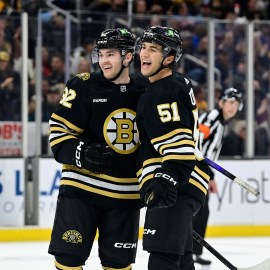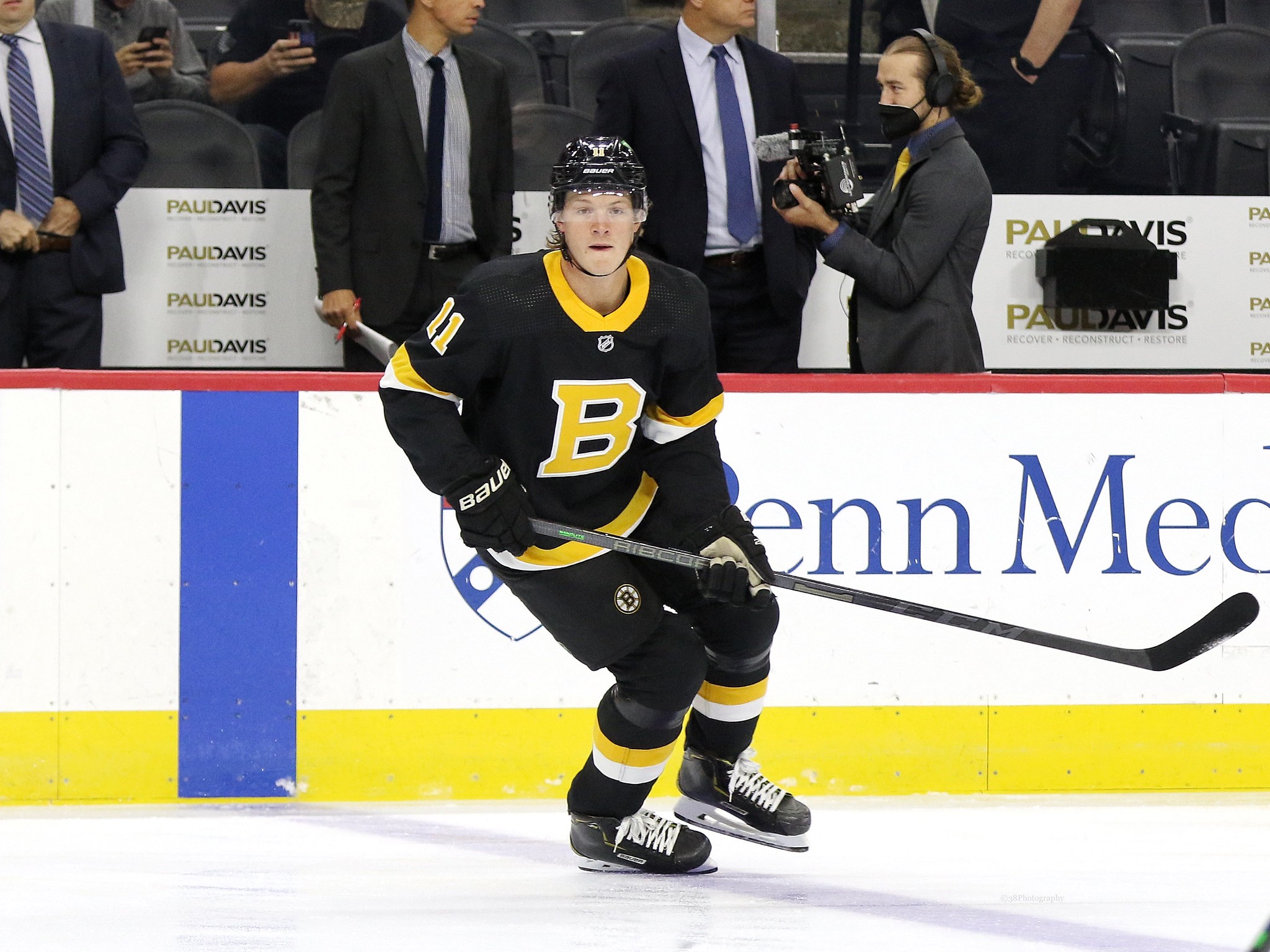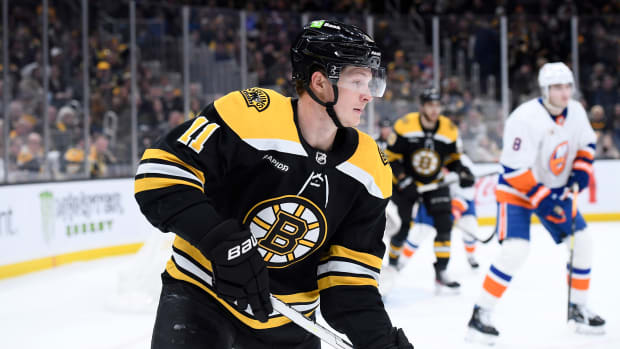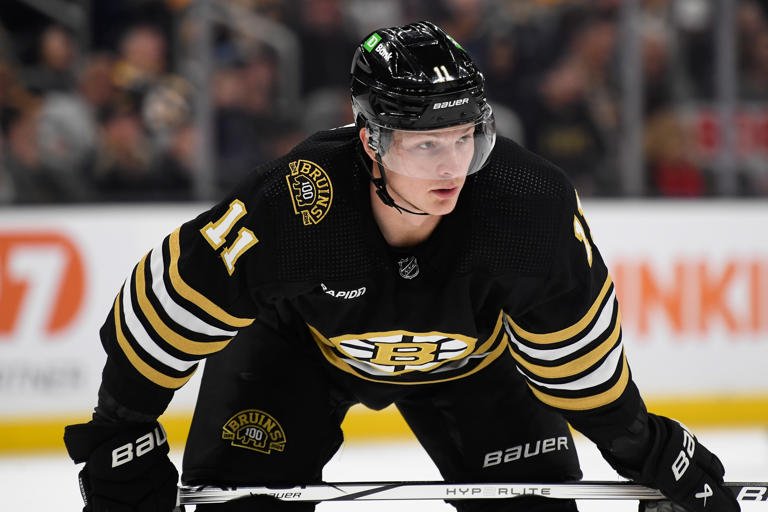If George Parros or Bill Daly calls Boston Bruins President Cam Neely on Monday, it will serve as a gentle reminder of how things used to be done in the National Hockey League in the year 2023.
During Saturday night’s 2-1 overtime loss to the New York Rangers at TD Garden, NESN site reporter Gayle Troiani had pointed out that Trent Frederic was just one assist away from everyone’s all-time favorite vintage hockey hat trick, the “Gordie (Howe).”
Later on, Frederic got his licks on Rangers captain Jacob Trouba, whose two-handed stick strike to Frederic head on November 25 in New York was punished only after the fact by the National Hockey League’s maximum $5,000 fine. Frederic had scored the game’s opening goal early in the second period.
It was the most embarrassing miss of the season for on-ice officials in the National Hockey League, and despite the fact that the meagre fine is governed by collective bargaining, it also made the Department of Player Safety of the league look awful.

Frederic was pushing Trouba’s top hand away from the Boston net during a post-whistle confrontation in that game. As the Rangers captain recoiled, Frederic shrugged off the Boston Bruins winger’s gesture and continued that motion into a hard swing, which jarred the side of the Boston forward’s helmet. Trouba was able to avoid the Boston net.
Without taking into account the plastic protection, Trouba’s aggressive hack had the potential to put an end to Frederic career. For the hockey helmet that has received a lot of criticism, “Chalk one up.” Without a shadow of a doubt, Frederic was more upset after watching the tape than he was at the time the event actually took place.
On Saturday, they engaged in a fight during the second quarter. Before both of the competitors were knocked down to the ice, Frederic delivered a powerful punch.

“I will never be able to hit him with the same force that he hit me with. It would take me ten fights against him to do it. Frederic , who did not hesitate to hint that their battle does not, in reality, result in the conclusion of the story, stated that this is one of the things that makes hockey so enjoyable.
When it comes to the topic of revenge, the National Hockey League (NHL) has taken a firm stance with its players and teams ever since Gary Bettman became the commissioner in 1993. This stance is akin to saying, “We are the justice department, you skate your lane.”
Over the course of the 19 seasons that have passed since the introduction of lightweight, synthetic sticks and stiffer enforcement requirements for clutch-and-grab hockey, management teams have shifted their attention on skill, which has resulted in the marginalization of the enforcer.
The assailant is leaving… to the point where hockey advocates are demanding that the National Hockey League (NHL) make it official and put an end to the era in which fighting is permitted.

I’ll give them this much: the notion that having a gangster in your lineup is a deterrent to dirty play has always been a fallacy. I’ll give them this much. That being said, the toughness and intimidation that is necessary for a team to succeed in the playoffs permeates the top tiers of the lineup; it does not only nibble around the edges, as in the case of 5:00 ATOI in the playoffs.
The National Hockey League’s obsession with appearances has only grown more intense in this age of social media. The National Hockey League (NHL) is particularly interested with expanding its viewership beyond stereotypes, despite the tremendous uproar that has been caused by the league’s recent restriction on special postgame sweaters that are tied to a cause.
How come? Because the non-traditional sector of the market has grown more significant than the traditional sector’s comfort zone (that is, it is beneficial to business), the traditional sector has become less relevant. In the event that this were not the case, former Boston Bruins coach Don Cherry and former Boston Bruins defenseman Mike Milbury would still be employed in the field of broadcasting on national television.
Concurrently, the advent of chronic traumatic encephalopathy (CTE) as a well-known deterioration of the brain caused by repetitive physical blows has altered the way in which the league deals with fighting, which is theoretically still permitted in professional hockey and is punishable by a major penalty that lasts for five minutes. The point at which this rubber meets the road is, however, in the bouts that are permitted.

In the past, it was rather uncommon for two opponents to fight as a result of anything that happened during the course of the game. However, this practice is no longer permitted. There are numerous instances in which these confrontations are broken up before they even begin to take place.
Due to the fact that it brings attention to an issue, the staged fight that occurred in the 1990s has been downplayed. However, it has been discreetly supplanted by a new form of manufactured conflict, more specifically, the one-on-one combat that the National Hockey League (NHL) hopes will put an end to a feud.
A defenseman receives a significant bodycheck and is then maneuvered into a brawl that, from a hockey perspective, is advantageous to the opponent.
As to why this is permitted. Since the National Hockey League does not want its players or the game itself to become furious. There is a fear within the league that another Montreal-Quebec or Montreal-Philadelphia match will occur in 1984 or 1987. The league desires for its scores to be settled in a manner that is both abrupt and secure, under the Marquis of Queensbury Rules, and in tiny, digestible pieces.
Therefore, commentators selected by the league are always the first to chastise players and teams with public announcements proclaiming that this little bout is the final word on the topic and that we should not hear any more words about it. The only thing that Matt Cooke could desire for now that this new code is crystal clear is to play.
It is possible that the postgame interview that Frederic gave could generate alarm in the offices of the NHL. The open-ended perspective that he holds is in direct opposition to the recently established principles of game and sport management. This week, if Neely receives a phone call, it will be to inform him that the fire on Frederic-Trouba has been extinguished, and it will be extinguished immediately.
When Frederic was a little boy growing up in the St. Louis region, former Boston Bruins left winger John Wensink, who was in Boston this past weekend with Stan Jonathan and other select Bruins from the Lunch Pail period, assisted Frederic in making his way through the coaching process.
“The kid is a St. Louis kid, and I adore him,” she said. I was one of his coaches in the Quebec peewee tournament, and I absolutely adore the way he plays,” Wensink remarked in response to a question posed by Matt Vautour of Mass Live regarding which current Bruin would be a good fit for the Lunch Pail Gang of the late 1970s. “Not only is he a wonderful child, but his family is also an outstanding family. I have a lot of desire for him.
Off the rink, Wensink is a kind and gentle guy who, while he was babysitting his daughter, fashioned a doll house. Decades later, he assists his daughter by transporting his grandson to hockey practice for the team that is located south of St. Louis. It appears that he is ashamed when he is asked to describe his historic challenge to the incumbent of the Minnesota bench.

“Earlier in the season, on October 26, we played in Minnesota, and a few of us, along with Don (Cherry, our coach), made a commercial for the North Stars to promote the idea that they were going to be a more challenging club. Wensink recalled the incident that took place at Boston Garden on December 1, 1977, when he and Terry O’Reilly handed simultaneous beatdowns to Alex Pirus and Steve Jensen. “That was maybe in the back of my mind,” Wensink remarked. “The adrenaline was pumping, and to tell you the truth, I don’t believe there was any reason behind it other than the fact that it was purely spontaneous and fueled by pure excitement. I suppose that it was a moment of weakness.
Due to the fact that the event became so well-known in the history of hockey fights, Wensink is frequently asked to re-enact the notorious offer when he is invited to participate in charity games; nevertheless, he denies the request. In the course of his pregame introduction to the Boston fans on Saturday night, he made a brief visit by the Rangers bench in order to hand out the fictitious invitation.
During the first intermission of Saturday night’s game, he commented, “Actually, tonight is the first time I’ve actually done it on the ice in front of another team in front of fans and that, because I was always afraid that maybe the team would come off the bench.” This statement elicited laughter from a press scrum that was packed with people. “For as long as I can remember, I’ve always ignored it, and I just – it was one of those moments. Considering that it has been around for a very long period, this is not a horrible moment.
The legacy that Wensink leaves behind is that of an enforcer; nevertheless, during the 1977–1978 season, the left winger came closer than four goals to adding a 12th 20-goal scorer to the Bruins’ still-standing record of 11 in the National Hockey League. The next year, he got off to a blazing start, scoring eight goals in the first seven games of the series for Boston. He suffered a drought of seven games before scoring 15 goals in his last 23 games, and he concluded the 1978-1979 season with 28 goals.

After I retired, I moved back to St. Louis, and now I’m having conversations with some of the Blues’ former members. It’s really funny when you think about it. “I would have been able to get a few more if I had known how much room I had out there when I was playing,” said Wensink, whose duty was to be at the net ready to pounce on what Peter McNab or Terry O’Reilly created. Wensink didn’t know how much room he had out there.
In spite of the fact that there were a number of tough teams in the 1970s, none of them were nearly as tough as the Boston Bruins led by Wayne Cashman in the late 1970s. O’Reilly was at the height of his career, and Wensink, Stan Jonathan, and Al Secord were all emerging as stars.
Wensink made the observation that Bobby Schmautz, who passed away, was a frightening opponent to compete against. “Schmautzie wasn’t a heavyweight,” Wensink said. It never seemed to matter to me which line was going to be the next one to be released. We were able to roll four lines over, and I believe that a lot of it kind of contributed create the lunch-pail thing. There was an aspect of each, a playmaker and a physical player, so we were able to roll four lines over. You are aware that we go to work and perform our duties. Following the completion of our tasks, we will go out and celebrate while having a nice time.
